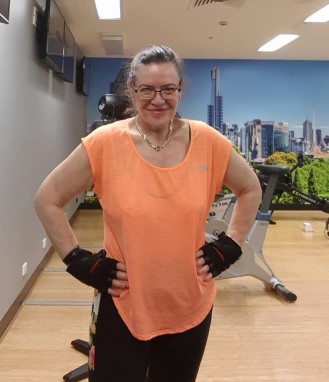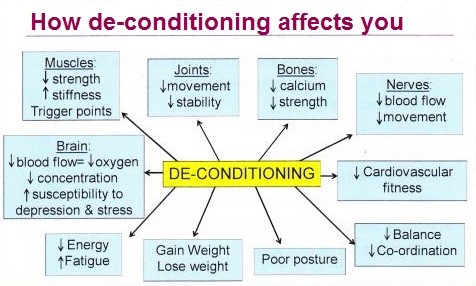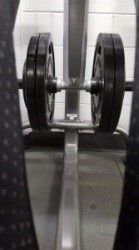Welcome to ThatChronicPainGuy Guest Blog 2. Read on and learn a bit about Robyn, her conditions, and her work helping others with chronic conditions. Josh

Robyn Dunphy is an accountant and IT professional who retrained in Exercise Guidance when she developed autoimmune arthritis, among a plethora of other medical conditions. Firmly adhering to pain management through exercise and re-conditioning of the body, Robyn wanted a new career with lots of movement (not lots of sitting as accountants tend to do). Robyn is now an exercise guidance professional, specialising in assisting people with chronic medical conditions. Robyn holds a Bachelor of Business Administration, is a Certified Practising Accountant and has attained Certificate III and Certificate IV in Fitness. Robyn also holds the required Working With Children Check and First Aid certifications and is a professional member of Physical Activity Australia and Move. Robyn writes about managing pain through movement at Limberation”
Well, there’s professional Me. Here’s actual me in terms of medical conditions…
- rheumatoid arthritis (but maybe psoriatic arthritis, or both) (autoimmune)
- hyperactive thyroid, multi-nodular goitre, Graves disease (autoimmune)
- diverticular disease (most of us have some degree of this, by the way)
- bulging disc, lumbar spine
- herniated disc, lumber spine
- arthropathy and hypertrophy of various facet joints
- scoliosis lumber spine
- sliding hernia (doesn’t bother me)
- photosensitive eczema (result of medications)
- other skin stuff going on (medications again)
Impressive huh? And that’s after I’d already lost all the “optional extras” (as one professor put it): tonsils, appendix, uterus, gall bladder.
Your doctor may have told you to get exercise. That’s probably the last thing on your mind. You’re sick, permanently, and you’re being told to exercise?! Well here’s why.
If you’re not a professional athlete, then I’m going to assume you are a desk jockey and have been rather slack about exercise in the past. Maybe you don’t even own runners. Or shorts. Do you even know where your local gym is? Don’t worry about that yet, we take this in small steps.
You may be asking yourself “How tough is it really, to get moving?” How tough (or easy) will depend on:
- your specific condition,
- were you diagnosed early and therefore received appropriate medical care early,
- your pre-diagnosis level of activity,
- the medications you are on,
- the symptoms you specifically experience.
“But”, you cry, “why does it have to be exercise? I’m hurting! I have no energy! I’m tired!”
The objective of moving is to prevent de-conditioning. De-conditioning can lead to more pain.

MY RE-CONDITIONING JOURNEY
I’ll share some of my own journey but as you read please be aware your situation may be entirely different. What applies to me may not apply to anyone else at all.
I wasn’t completely starting from scratch – while I’d had an activity hiatus for roughly four years, I did have a gym junkie background to leverage. Or so I thought. In the beginning it certainly didn’t feel like I was leveraging anything!
So, what did I do? I should have started with stretches, but at the time I didn’t know that – so please start with stretches! I outline a good basic stretch session in “Let’s Stretch”.
AT THE STARTING LINE
When I started (late 2014), I started very slowly. I did five-minute walks four times a day. It didn’t take me long to realise I felt better when I moved. Pain and stiffness receded very quickly once I was MOVING. I increased to ten-minute walks, three times a day. Finally, I got to twenty-minute walks, twice a day. No amount of activity is too small to start.
I didn’t do any strength (resistance) work at all in the beginning. I added some swimming: gone were my 2.5 km sessions: my physio was advising I swim 250 metres. I mumbled and grumbled that 10 laps wasn’t worth getting in the pool for, but I did stick to her advice the first time. Listen to your physio (or listen to me), don’t hurt yourself trying to push too hard.
RESISTANCE WORK
 It wasn’t until late 2015/early 2016 I got back on the weights. I’d always liked the leg press but had no idea what I should try to start with. Prior to the autoimmune arthritis and the hyperthyroid diagnosis, I’d been diagnosed (by MRI) with meniscus tears in my left knee, not a lot of cartilage to speak of and I’d had a Synvisc shot. I was understandably cautious, but knew I was continuing to lose muscle strength which wasn’t going to help me long term at all. I needed strength to support my joints, especially the damaged ones.
It wasn’t until late 2015/early 2016 I got back on the weights. I’d always liked the leg press but had no idea what I should try to start with. Prior to the autoimmune arthritis and the hyperthyroid diagnosis, I’d been diagnosed (by MRI) with meniscus tears in my left knee, not a lot of cartilage to speak of and I’d had a Synvisc shot. I was understandably cautious, but knew I was continuing to lose muscle strength which wasn’t going to help me long term at all. I needed strength to support my joints, especially the damaged ones.
I loaded 10 kg weights on either side of the leg press and felt SO frail. I was in my school gym – most (not all) fellow fitness students were athletic and I felt like I didn’t deserve to be there. I upped the weight to a total of 60 kg quite quickly. From 60 kg to 100 kg took quite a bit longer. If I recall correctly, I got stuck around the 80/90 kg mark for quite some time.
OTHER CONSIDERATIONS
Sometimes progress stalls. I find I lose gains very quickly if I miss a strength workout. Whether this is due to medications, the conditions themselves, my age (yes, I do have to consider that these days) or a combination of all three, I’m not sure.
In late July 2016 I had a change of medication. I found this helped dramatically with the fatigue and therefore it has helped all the other aspects of my re-conditioning.
OBJECTIVE ACHIEVED!
As you can see, it isn’t achieved overnight. I’ve worked at it. Slowly, but surely, I’ve achieved my original goal: to stay off pain medications.
Thanks,
Robyn.
Disclaimer: This article is based in part on personal experience and is of a general nature, not tailored for any individual circumstances. Where appropriate, readers should seek medical clearance before embarking on an exercise program.
Photos: Provided by Robyn
Want to be a guest blogger? Contact me! Whether you live with pain, know someone with chronic pain, and/or help people with chronic pain – it’s all valid and useful. No subject too small or big, or too funny or not funny enough! Write me and we can collaborate. Cheers, Josh.
Thank you for sharing Josh. I hope your readers may find something of use. 🙂
LikeLiked by 1 person